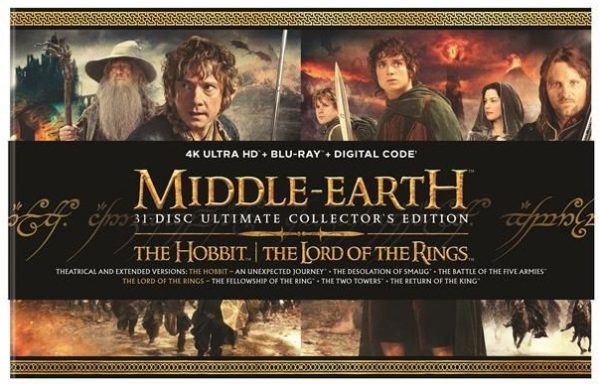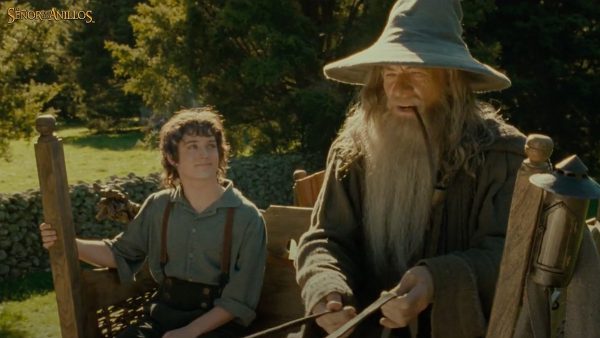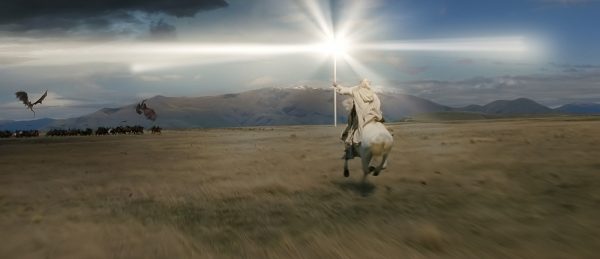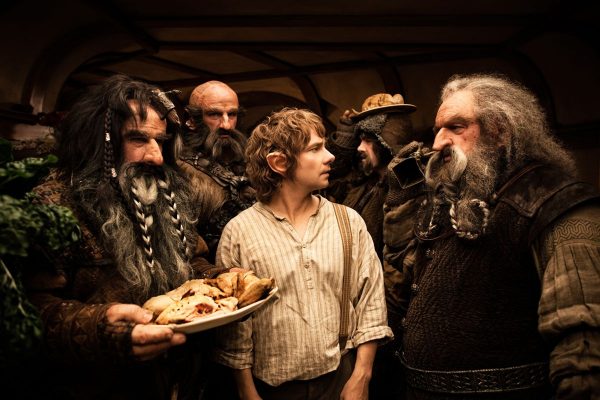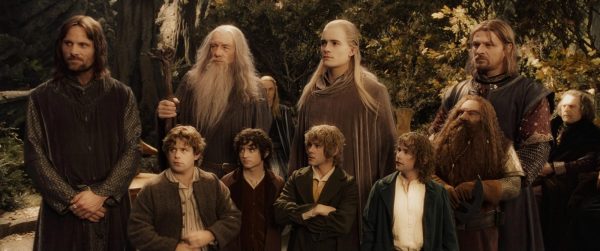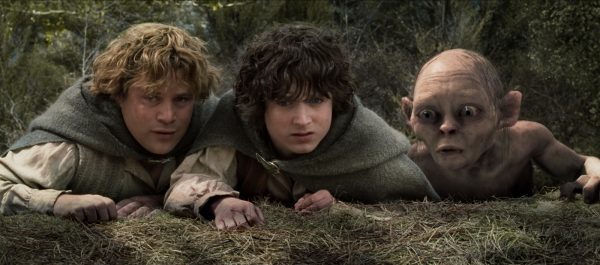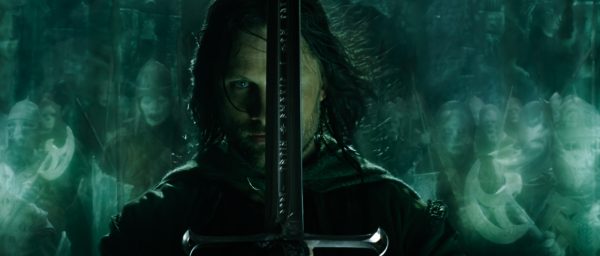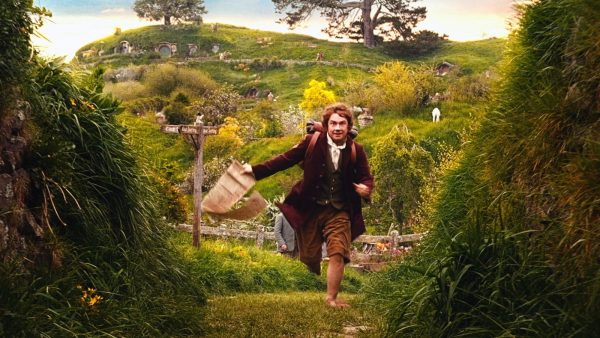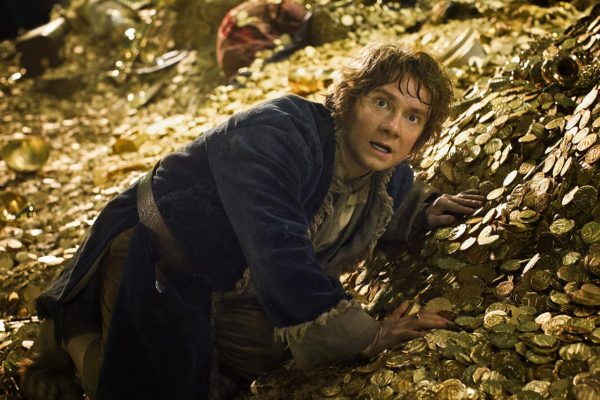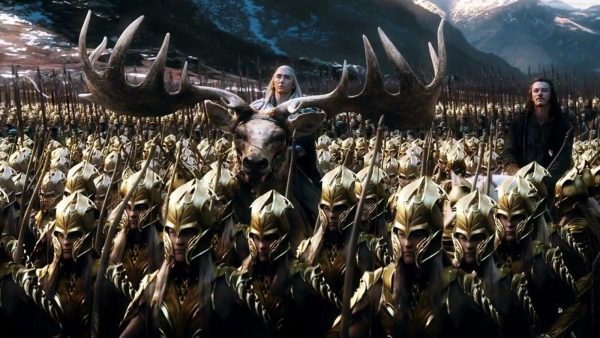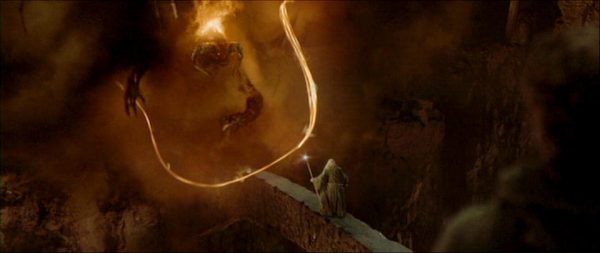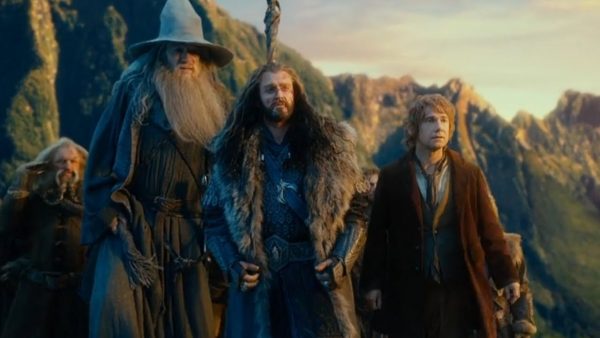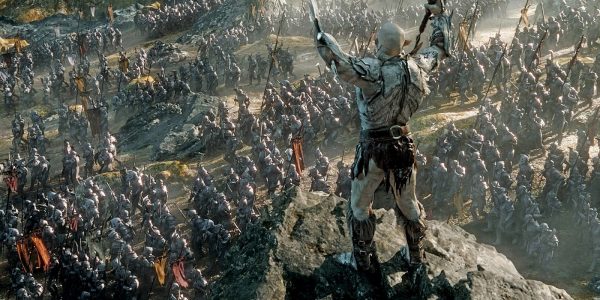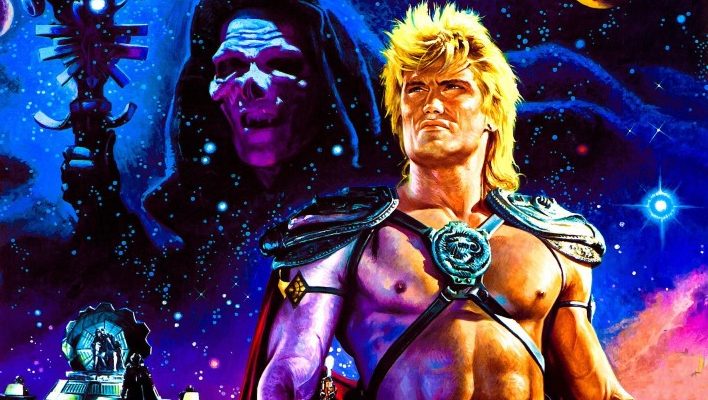Middle-Earth Ultimate Collector’s Edition
Directed by Peter Jackson.
Starring Elijah Wood, Ian McKellen, Liv Tyler, Viggo Mortensen, Sean Astin, Cate Blanchett, John Rhys-Davies, Christopher Lee, Billy Boyd, Dominic Monaghan, Orlando Bloom, Hugo Weaving, Andy Serkis, Sean Bean, Martin Freeman, Richard Armitage, Benedict Cumberbatch, Evangeline Lilly, Lee Pace, Luke Evans, James Nesbitt, Ken Stott, Stephen Fry, and Ian Holm.
SYNOPSIS:
Just in time for the holidays, Warner Bros. has released a Middle-Earth Ultimate Collector’s Edition that comes in what they call “puzzle box” packaging, complete with gorgeous 4K transfers of all six films’ theatrical and extended editions, a new disc of bonus content, some nice physical swag, and codes for digital copies. Some older extras are missing, but with 31 discs in this set, there’s more than enough to keep Tolkien fans busy.
It’s been 20 years since The Lord of the Rings: The Fellowship of the Ring arrived in theaters. (I’ve also published a retrospective that looks back on both trilogies.) To commemorate the anniversary, Warner Bros. has released a Middle-Earth Ultimate Collector’s Edition that comes in what they call “puzzle box” packaging.
Inside, you’ll find the theatrical and extended versions of all six films on 4K Ultra HD and Blu-ray discs, along with some physical collectibles and a new bonus disc with the original Cannes Film Festival presentation reel and footage from the recent cast reunions moderated by Tolkien mega-fan Stephen Colbert. There are 31 discs total in this set.
Previous bonus features, such as the Appendices from the old Lord of the Rings DVD editions, aren’t found here. However, you do get codes for digital copies of all 12 versions of the films, and I noticed that a lot of bonus features were included when I checked the films in my Vudu account, including those aforementioned Appendices. However, I don’t know if everything can be found there, and it’s important to note that things can disappear from streaming services due to rights issues or other legal matters.
The physical collectibles include a 64-page booklet featuring costumes, photography, and production notes from the films. You’ll also find art cards that treat various Middle-Earth locations, such as Rivendell and The Shire, as travel destinations.
And, of course, the movies look incredible in 4K. These are the same 4K discs that were released last year, and the included Blu-rays use the same source files as the other discs, so any minor issues that affected previous 2K editions, particularly with The Lord of the Rings, have been rectified here. The extended versions of the Lord of the Rings films are split across two platters on Blu-ray and 4K but they’re contained on one disc for the Hobbit films.
The Blu-rays look nice, but the images really pop off the screen in 4K. These are films that take full advantage of HDR: The Shire’s rolling hillsides are a beautiful iridescent green, and the golds and silvers found in Rivendell are lustrous. The One Ring is a brilliant gold that immediately catches your eye, much like the Ark of the Covenant does in Paramount’s 4K presentation of Raiders of the Lost Ark. Fine details, such as the textures of fabrics and the folds of old paper, are easily noticeable too.
The Hobbit films already take advantage of 4K, which isn’t a surprise since they were shot digitally, so the improvement is more pronounced with The Lord of the Rings: in those movies, it’s clear that they were remastered in 4K with painstaking attention to detail. Sure, you can probably freeze-frame moments from the first trilogy and find little things to nitpick, especially in the visual effects shots that were composited with older-generation digital technology, but when you’re watching in real time, you’ll simply breeze by much of that. I recommend sitting back and letting all six films wash over you in 4K.
Now let’s move on to the individual films, in the order they were released, along with a rundown of the bonus features.
The Lord of the Rings: The Fellowship of the Ring
This is the one that kick-started the Tolkien phenomenon in 2001. I can still remember the feeling of pure joy that came over me when watching this film in the theater; it was like Peter Jackson reached into the book and pulled out a movie that closely matched the one I had always seen in my head. The Star Wars prequels were in the process of leaving something to be desired back then, but this movie demonstrated how wonderful a franchise could be.
Any time I watch the Lord of the Rings films, I always go with the extended versions. While the Hobbit movies were a mixed bag for me (more on that later), the Lord of the Rings book has so much rich material to mine, especially when you consider the appendices, that more really is better here. In the case of Fellowship, you get an extra half-hour of deleted and extended scenes that add more color to the story and help set up plot points in the next two films.
Flickering Myth Rating – Film: ★★★★★ / Movie: ★★★★★
The Lord of the Rings: The Two Towers
The Lord of the Rings trilogy continued with a second film that fulfills the premise of any great second act: Our heroes find themselves in disarray and all hope seems lost. The Fellowship is broken, leaving Frodo and Sam to continue on their arduous journey by themselves, tracked by the creature known as Gollum. Gandalf is gone and Boromir is dead. Merry and Pippin have been taken by Orcs and Aragorn, Legolas, and Gimli have set out to rescue them.
Like any great second act, however, The Two Towers concludes with hope on the horizon for our heroes; there’s the tantalizing promise of a hard-won victory in the third act. The extended edition of this film adds 44 minutes of deleted and extended scenes that create a richer narrative, with more nooks and crannies for Tolkien aficionados to explore.
Flickering Myth Rating – Film: ★★★★★ / Movie: ★★★★★
The Lord of the Rings: The Return of the King
The Lord of the Rings trilogy’s third film delivers on the promise of great third acts: Against all odds, our heroes prevail. Frodo and Sam strike an uneasy truce with Gollum as the trio make their way to Mount Doom. Gandalf the White joins the rest of the main characters for multiple battles, culminating in the epic Battle of the Pelennor Fields.
The third film’s extended version has the most added footage of the trilogy: a whopping 51 minutes were tacked onto a movie that scored major wins at the Oscars that year. And, befitting a finale, much of that extra content isn’t just fluff: for example, we get to see Saruman’s fate. Highly recommended.
Flickering Myth Rating – Film: ★★★★★ / Movie: ★★★★★
The Hobbit: An Unexpected Journey
And now we come to the second trilogy. I tend to be a “shades of gray” kind of person, so, for me, The Hobbit films were a mixed bag. I agree with the argument that this kid-oriented adventure story became something much different when Tolkien wrote his sequel and went back to revise some of the first book, such as making it clearer what the ring was that Bilbo found in the “Riddles in the Dark” chapter.
So it made sense to me that Jackson wanted to mine the Lord of the Rings appendices for additional content for these films, such as Sauron beginning his return to Middle-Earth in the form of the necromancer at Dol Guldur. And for my money, that’s what makes the first film in the new trilogy a strong first act, whether you’re viewing the theatrical or extended version.
Flickering Myth Rating – Film: ★★★★ / Movie: ★★★★
The Hobbit: The Desolation of Smaug
The second film was where the Hobbit trilogy started to go off track for me. Not only did Jackson and company pull Legolas into the story from left field, but they invented a new female elf character, Tauriel, and gave her a love interest among the dwarves. That part of the plot really felt like padding to justify adapting Tolkien’s book into three films rather than two, which was the original plan, and the extended edition did nothing to change that feeling.
On top of that, there were scenes, particularly the barrel escape sequence, that had such a videogame feel to them that I wondered if visual effects artists at Weta Digital were mashing controller buttons. Not every action scene felt that way, of course, and there’s enough good stuff in Desolation of Smaug to make it worth repeat viewings, but I’ve always felt the movie could have been better, had it been combined with the third installment.
Flickering Myth Rating – Film: ★★★ / Movie: ★★★
The Hobbit: The Battle of the Five Armies
The Hobbit trilogy wrapped up with a third film that was lighter on videogame-like special effects sequences but just as heavy on the Tauriel and Legolas sub-plot, which feels like mediocre fan fiction. Sure, there’s a rousing finale here, complete with a huge battle that’s made pretty clear by the title of the film, but I’ve always felt that it could have easily been combined with the second installment to create a leaner, meaner two-film adaptation.
As with the second film, The Battle of the Five Armies’ extended edition just makes the film feel more bloated and flabbier. Whereas The Lord of the Rings movies benefitted from all the extra content, The Hobbit’s bonus footage feels like a marketing ploy to sell more discs to Tolkien fans.
Flickering Myth Rating – Film: ★★★ / Movie: ★★★★
Bonus features
None of the 4K discs in this set have any bonus features, so all the extras are found on the Blu-ray platters. Each of the Hobbit theatrical and extended edition discs has an installment in the three-part New Zealand: Home of Middle-Earth featurette, which runs close to 20 minutes total. As the name implies, it’s about the filming locations used for each film.
The Hobbit extended editions also have commentary tracks with director Peter Jackson and screenwriter Philippa Boyens, and the Battle of Five Armies extended edition disc has three trailers. Jackson and Boyens are no strangers to doing great Tolkien commentary tracks, but in this case, even Jackson’s participation in those discussions feels as rushed as the creation of the three Hobbit movies was. For example, he begins his discussion of the second film by talking about how he’s been working on the third film and has his mind on that story, so he has to mentally switch gears now. The tracks are still worth a listen, of course, especially if you’re a fan of the films.
The Lord of the Rings theatrical Blu-rays contain trailers while the extended edition Blu-rays port over some Easter eggs and four commentary tracks per film, all from those amazing DVD sets. (I hope you’ve held onto yours. I have, simply because I love the packaging that’s made to look like old books.)
The Easter eggs are: a parody of the Elrond’s Council scene with Jack Black inserted, which was shown during the MTV Movie Awards (do those still exist?); a 3.5-minute theatrical preview of The Two Towers; Andy Serkis and Gollum giving a very funny acceptance speech from the MTV Movie Awards; Dominic Monaghan’s prank interview with Elijah Wood during the press tour for The Return of the King; and Ben Stiller and Vince Vaughn’s pitch for a sequel to Peter Jackson, which goes as you’d expect.
The four commentary tracks for each extended edition feature: Jackson, Boyens, and co-writer Fran Walsh; members of the design team; members of the production and post-production teams; and members of the cast. With the exception of the first commentary, the participants in the other three tracks vary. As you might imagine, they’re all rich with information, especially since they were recorded way back when the Lord of the Rings films were selling many millions of tickets at box offices worldwide and all the participants were flush with excitement.
Finally, we have the 31st and final disc in this massive collection, which gathers together the original Cannes Film Festival Presentation Reel (27 minutes), as well as three reunion chats moderated by Stephen Colbert for Alamo Drafthouse events earlier this year.
The Cannes reel is an intriguing artifact from a time when it’s easy to imagine that Jackson and company were nervous about how those three epic films would fare in general release. Those 27 minutes were the first opportunity anyone in the public had to see footage from the films, and while that might have seemed like a long promo reel to sit through, I can only imagine that it had no trouble capturing the attention of the audience, even one full of jaded members of the film industry. It’s easy to look back and assume that of course the movies would be hits, but you have to remember that no one knew that back then.
The three reunion chats are divided by film, with the following participants: Billy Boyd, Dominic Monaghan, Sean Astin, and Elijah Wood (The Fellowship of the Ring; 39.5 minutes); Cate Blanchett, Orlando Bloom, Liv Tyler, and Viggo Mortenson (The Two Towers; 32.5 minutes); and Ian McKellan, Andy Serkis, and Peter Jackson (The Return of the King; 29.75 minutes).
As you might imagine, Colbert does an excellent job of moderating the discussions through his mega-fan lens. A few interesting tidbits of info emerge from the chats, including: Jackson’s revelation that more movie footage exists somewhere in a Warner Bros. mountain vault (that might seem like hyperbole, but I assume it’s a good environment for storing film); the four Hobbit actors’ tales of real-life friendship; and the fact that McKellan might not have been cast as Gandalf, had he not answered his front door when Jackson paid him a visit.
The promise of more film footage is a tantalizing one, and my understanding is that there’s even more on-set footage, as well as a variety of promotional materials, that could be added to a future collection. But while this may not really be an Ultimate Collector’s Edition, it’s still enough to satisfy many Tolkien fans, especially the ones who haven’t bought the movies in 4K yet.
Brad Cook
